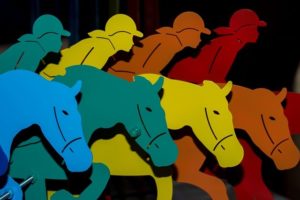Who is Rachael Blackmore?
Nowadays, Rachael Blackmore is stable jockey to Henry De Bromhead and her rise to prominence has gone hand-in-hand with that of the Co. Waterford trainer in recent years. Born in Killenaule, Co. Tipperary in July, 1989, Blackmore was, by her own admission, an ‘extremely average’ amateur jockey, but nevertheless turned professional in March, 2015, because she ‘just needed the practice’.
She rode her first winner as a professional, Most Honourable, trained by John ‘Shark’ Hanlon, in a handicap hurdle at Clonmel in September, 2015. The following season, 2016/17, Blackmore rode 32 winners and became the first female jockey to be crowned Irish Champion Conditional Jockey. Subsequent seasons yielded 34, 90 and 61 winners, respectively and in 2020/21, so far, she has ridden 82 winners and trails only reigning champion Paul Townend, by just four, in the race for the Irish National Hunt jockeys’ title.
Blackmore rode her first winner at the Cheltenham Festival, A Plus Tard, in the Close Brothers Novices’ Handicap Chase in 2019 and her first Grade One winner, Minella Indo, in the Albert Bartlett Novices’ Hurdle at the same Festival three days later. She has since added eleven more victories at the highest level, including Honeysuckle in the Close Brothers Mares’ Hurdle at the 2020 Cheltenham Festival.
 Although he British Champion Jockey in 2006, 2008 and 2009, Ryan Moore has, since 2015, been first choice jockey to Aidan O’Brien at Ballydoyle Stables, Co. Tipperary. Indeed, it was in that capacity that he completed the 1,000 Guineas – Oaks double for the first time in 2016 and did so again in 2020. Moore had won the 1,000 Guineas twice before, on Homecoming Queen, trained by O’Brien, in 2012 and Legatissimo, trained by David Wachman, in 2015, and the Oaks once before, on Snow Fairy, trained by Ed Dunlop
Although he British Champion Jockey in 2006, 2008 and 2009, Ryan Moore has, since 2015, been first choice jockey to Aidan O’Brien at Ballydoyle Stables, Co. Tipperary. Indeed, it was in that capacity that he completed the 1,000 Guineas – Oaks double for the first time in 2016 and did so again in 2020. Moore had won the 1,000 Guineas twice before, on Homecoming Queen, trained by O’Brien, in 2012 and Legatissimo, trained by David Wachman, in 2015, and the Oaks once before, on Snow Fairy, trained by Ed Dunlop